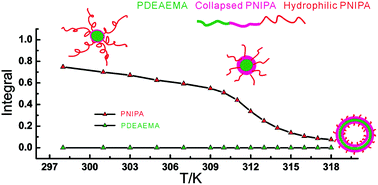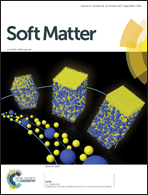Inhomogeneous-collapse driven micelle–vesicle transition of amphiphilic block copolymers†
Abstract
Understanding the morphological transition dynamics related to the hydrophilic–hydrophobic interface has been a challenge due to the lack of an effective evaluation method. Herein, nuclear magnetic resonance spectroscopy was employed to study the morphological transition related chain collapse of poly(N,N′-diethylaminoethylmethacrylate)-b-poly(N-isopropylacrylamide) (PDEAEMA133-b-PNIPA322) and poly(N,N′-dimethylaminoethylmethacrylate)-b-poly(N-isopropylacrylamide) (PDMAEMA95-b-PNIPA228) and was proved to be a powerful technique in morphological transition mechanism studies once combined with dynamic light scattering and transmission electron microscopy. Unlike the cooperative coil collapse of two blocks in the PDMAEMA95-b-PNIPA228 alkaline solution upon heating which induces the assembly of a nanostructure (∼200 nm) with a hydrophobic core containing both collapsed PDMAEMA and PNIPA segments and a hydrophilic surface part consisting of un-shrunk PDMAEMA and PNIPA segments, PDEAEMA133-b-PNIPA322 with a low-temperature core–shell micelle structure showed a micelle–vesicle transition due to temperature-induced inhomogeneous-collapse of PNIPA. The PNIPA segments in the shell sequentially collapse outside (starting at the core–shell interface), accompanied by a gradual decrease in micelle size. Above the critical temperature, the residual hydrophilic PNIPA segments become too short to stabilize the micelle structure, the micelles then transform into vesicles of a slightly larger size, instead of micelle aggregation and precipitation as normally expected.


 Please wait while we load your content...
Please wait while we load your content...